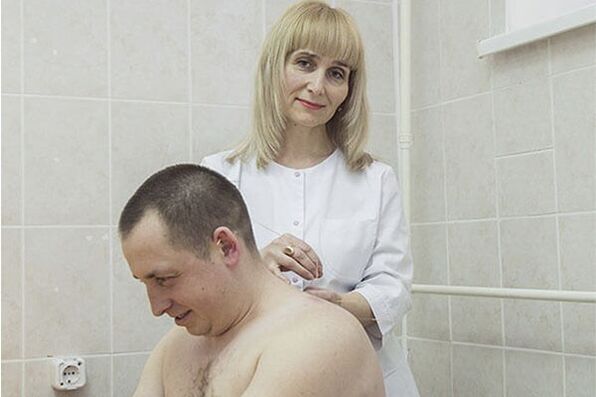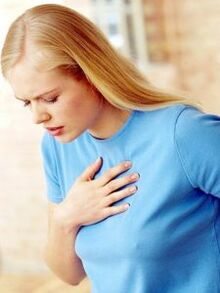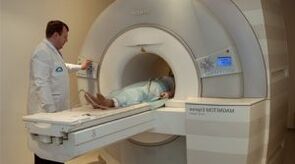The osteochondrosis of the thoracic spine is a disease of the musculoskeletal system, the success whose treatment depends on the timeliness of the diagnosis.It is completely treated in the early stages, but it can be difficult to determine the source of the disease, since the patient initially does not suspect that the pain and discomfort that arose are associated with damage to the spine: they are not very disturbing it and is not quickly from the doctor.

We try to deal with the characteristic symptoms of osteocondrosis, the nature of its presence, the possibilities of treatment and prevention of the disease.
Osteochondrosis of the thoracic spine
- The disease is characterized by dystrophic and degenerative changes in the thoracic vertebral column, which are associated with cellular metabolism disorders.
- In the intervertebral discs, protrusion occurs (thinning and cracking): the cause of the compression of the spinal cord, numbness of the limbs, paralysis.This is the stage of the disease when only a surgical operation will help.
- The task of patients and doctors to adopt measures on timely diagnosis and adequate treatment.
Symptoms of the disease
The first symptoms of osteochondosis of the thoracic area of the spine:
- back pain (Dorsalgia);
- acute pain in the thoracic area (darsago);
- Discomfort during the movements, I don't want to move once again to not feel pain.
All of these are protected symptoms: thinning, cracking of intervertebral discs.The pain appears in the area of kidneys, liver, heart, pancreas, stomach.The pathologies of the thoracic region are manifested for intercostal neuralgia, transversal arthrosis and pectoral arthrosis.A deep sigh or a cough causes pain or sensation of compression or presence of a solid heavy coma in the chest.

Often the osteochondrosis of the spine is characterized by syndromes:
- Vasomotor syndrome characteristic of neurological diseases.The patient feels sudden redness, similar to climatic pain, of other organs, systems.
- Muscle-tono-tone syndrome in muscle tissues near the focus of the disease.With an increase in physical activity, these areas swell.
- Neurodistophone syndrome (Zuzhek disease) or metabolism in tissues can also become a symptom of the disease.
The difference from other diseases
The difficulty of diagnosis and the early diagnosis of the osteochondosis of the chest area is that its symptoms are easy to confuse with others.
For example, combs is not only a sign of breast osteochondrosis, but also myocardial infarction.
With damage to the spine, the symptoms of combination occur with head turns, torso and lasts for a long time, for more than two weeks.Nitroglycerin in this case is useless.For comparison: with coronary diseases, the same pain continues a short period of time."Cardon" drugs will help you get rid of or help significantly alleviate them.
Pain in the field of appendix, kidneys, stomach, intestine - symptoms of somatic diseases: appendicitis, nephritis, pieelonefritis, gastritis, stomach ulcers, colitis.During the compression (pinching) of the spinal cord, the characteristic symptoms of these diseases are manifested.Pseudo -Giose syndrome or a feeling of pressing, gravity in the chest differs from an angina, characteristic of patients with Angina pectis.These pains can be caused by the bull of the chest, part of the cervical and cervical part, causing painful processes of the surrounding tissues: muscles and nervous.The pain with pseudo -angiosa syndrome occurs with turns of the upper body.
The symptoms of compression syndrome are signs of an extramidorar neoplasm of the spinal cord.
Due to the similarity of the osteochondosis of the thoracic area of the spine with other diseases, the main thing is to diagnose carefully, for which complex measures are performed.
Development of the disease
Let's find out what happens when osteochondosis occurs:
- First of all, the disc is modified: it is sophisticated, covered with cracks, deformed.At this stage, the disease does not appear symptomatically and the patient feels nothing.
- So there are pains associated with the irritation of the nerve endings that are found in the tissues next to the records concerned.In people with developed muscle mass, the risk of pathological processes is much smaller, since the muscles support the spine, like a corset.Pain can be neurological, as innerpying the limbs, the appearance of goosebumps, the changes of the internal organs of the chest.
In the first two phases, the disease is treated.
- Subsequently, inflammatory processes, hernias, arthrosis, subluxation of individual vertebrae can develop.The most frequent are the hernias in which the core of the octopous spine, constantly supported by a fibrous ring.When the ring is destroyed, the strip nucleus, causing acute pain, numbness, paralysis.
- In the fourth phase there is a narrowing of the discs, abnormal growth of the bone tissue is possible.So the spine protects itself from the dangerous compression of the spinal cord.
In severe cases, squeezing syndrome the spinal cord due to the protrusion can cause attached pain, a decrease in sensitivity (investigating magistrate).
Factors of the development of the disease
The osteochondrosis of the thoracic spine develops due to the insufficient supply of intervertebral discs with useful substances and humidity.The discs of the spine differ from other body tissues as they are not supplied with nutritional elements through the ship's network and feed nearby tissues.With a lack of liquids, nutrients, a phenomenon called protrusion is characterized by protrusion, refinement, cracking and destruction of intervertebral records.
Degenerative changes appear for the following reasons:
- Hereditary, associated with the underdevelopment and pathology of blood circulation.
- Congenital, caused the appearance of weakness of the musculoskeletal system: rachit, kyphosis, scoliosis, prayer.
- The salt deposits next to the discs (osteophytes), publish a crew of the spine of the spine.
- Violation of nutritional metabolism, microcirculation in tissues following lesions and infectious diseases
People who are at risk:
- experiment with strong physical activity;
- with improper posture, in which in time there are the same pathological consequences as the injuries after;
- have a sedentary job;
- Work by profession associated with a long agitated organism (drivers).
When to see a doctor?
With the diseases of the spine to the doctor, you have to go quickly.How to understand that the case is in the spine?With osteocondrosis, it can be difficult to understand or not immediately.In the early stages, the pain is not felt.
Remember!If there are pain in the chest and back, whose exact source is difficult to determine, since it "fluttering" through the body: first it hurts side by side, therefore alternating - shoulder, ribs, clavicle, in any sequence.This is often a sign of damage to the thoracic spine.
Is it possible to alleviate the pain before meeting a doctor?
So far there is no accurate diagnosis, radical treatment methods are not used.The fact is that there are diseases in which, for example, thermal procedures are prohibited (with some types of tumors).With acute pain, the painkillers are drunk and an ambulance call.In other cases, heavy loads are excluded from the sedative, find a comfortable position of the body and avoids effects of acute shock (jumps).At the first occasion, they go to the doctor to confirm the diagnosis and prescribe the treatment.
Diagnosis of osteochondosis spinal in the chest area

Always conduct a complete examination aimed at eliminating diseases with similar symptoms.
Diagnostic methods include:
- anamnesis;
- Inspection and palpation;
- Computer tomography, which determines the exact diagnosis and clarifies the stage of the development of the disease;
- X -ray as an alternative method of tomography, capable of revealing cracks on the discs and strengthening formed;
- Ultrasound, ECG, gastroscopy, fluorography, general tests that exclude diseases, similar to symptoms similar to osteochdrosis.
The more complete diagnosis, the more accurate the diagnosis is.Together with the osteocondrosis, it is possible to detect other pathologies of the spine, this takes into account the doctor during the diagnosis and prescription of the treatment.
How to treat osteochondrosis of the spine?
The medical treatment of osteochondrosis will lead to the complete care of the patient if the diagnosis is carried out in a timely manner.
- First of all, it is addressed to relieve pain, for this purpose the drugs are prescribed: analgesics, blocking of the source of pain with novocaine injections, for some time releasing the patient from unbearable pain;
- Physio with currents, laser, magnetopuncal devices;
- aghleoflexetherapy or acupuncture, which is conducted by professional doctors;
- Therapeutic gymnastics under the supervision of a physiotherapist;
- The purpose of condroductors;
- The surgery is exchanged in serious cases, when other methods are useless.
Popular remedies
All popular methods for the treatment of osteochondosis are divided into pathogenetic and symptomatic.Pathogenetic - aimed at fighting the disease.These include:
- physiotherapy procedures;
- Massage starting from the study of weak points for 8-12 minutes, so the time has increased;The massage is shown only in the absence of acute pain;
- A diet, in which the patient refuses grapes and legumes, systematically accepts substances containing natural chondroitin, a substance that helps to strengthen intervertebral discs: meat in jelly, broth and.etc., the use of vegetables and fruits that contribute to cleaning the body is shown;
- During the appearance of acute pain - heating with salt, sand;
- acupuncture.
Symptomatic agents aimed at alleviating the symptoms of the disease include external and internal phytotherapy.
Disease prevention
To prevent osteochondrosis, in general, and osteochondrosis of the thoracic area of the spine, in particular, it is necessary to satisfy different conditions:
- sleep on hard surfaces and on cushions with a slope no more than 15 degrees, compared to the mattress;
- Avoid exorbitant loads on the spine and professions, associated with a trembling body;
- observe the right lifestyle;
- regularly drink water, prevent dehydration;
- Pregnant women are recorded in the early stages, use vitamins and elements that contribute to the correct development of the fetus;
- Rachion prevention in a child, which is a prevention of disorders in the musculoskeletal system.
The osteochondrosis of the spine is a disease that can be treated, especially in the early stages.On the following ones, if it was not possible to completely overcome the disease, there is no reason to despair.The existing treatment methods are designed to significantly reduce the patient's suffering.Early diagnosis, the execution of all the doctor's prescriptions can completely save the patient from the exhaustive disorder.
























